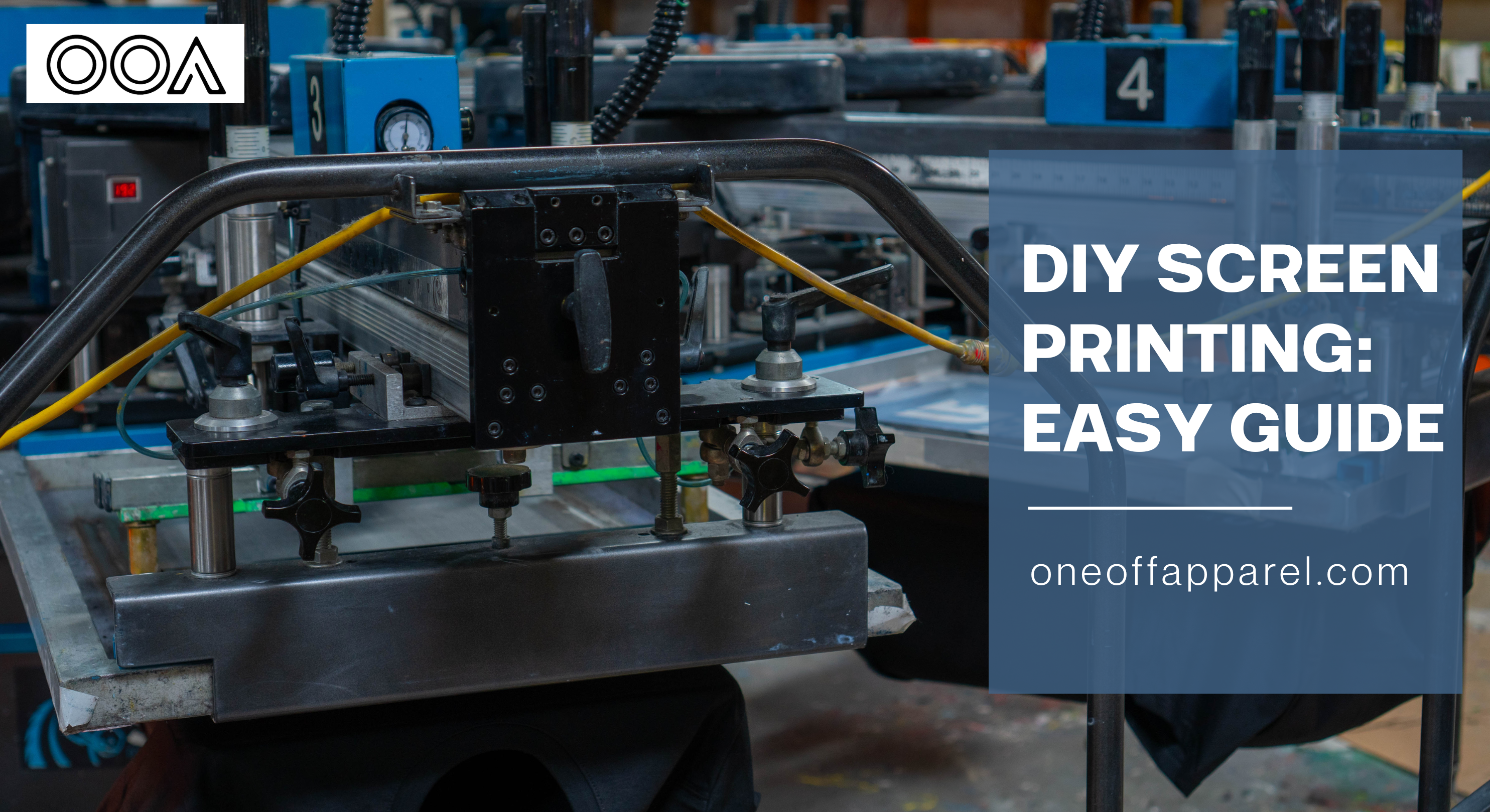
The artwork of creating custom-printed apparel at home has exploded in popularity among crafters, artists, and DIY screen printing enthusiasts. What was once the domain of professional print shops is now accessible to anyone with a bit of patience and creativity. With some basic materials and practice, your kitchen table can transform into a productive print studio.
While companies like One Off Apparel have mastered industrial screen print techniques, you can achieve impressive results right at home with DIY screen printing. The process might seem intimidating at first, but breaking it down into manageable steps makes it approachable for beginners and satisfying for those looking to expand their creative skills.
- DIY Screen Printing Kit : Essential Materials For Cheap Printing
- DIY Screen Printing Screens : How To Make A Screen Printing Frame
- Creating Your Stencil - Two Approaches
- DIY Screens For Screen Printing : The Printing Process
- DIY Silk Screen Printing Troubleshooting Common Issues
- What Materials Do I Need For DIY Screen Printing?
- DIY Silk Screen Printing FAQs (Frequently Asked Questions)
DIY Screen Printing Kit : Essential Materials For Cheap Printing
The beauty of DIY screen printing lies in its accessibility. You don't need industrial equipment or a massive budget to get started. A simple embroidery hoop from any craft store costs about $2 and forms the foundation of your printing frame. You'll need mesh material too-nylon, polyester, or silk with tiny holes works perfectly as your screen.
Photo emulsion (Speedball is widely available) serves as the light-sensitive coating that creates your design on the screen in a darkroom setup. Supporting materials include drawing fluid, screen filler, a small paintbrush for detail work, and a plastic spoon for mixing. Of course, you'll need screen printing ink in your chosen colors and a squeegee to apply it. Don't forget about the fabric items you want to customize, plus a 150-watt lightbulb and two piece of glass from inexpensive picture frames to complete your setup.
Many beginners find that purchasing a complete DIY screen printing kit simplifies the process by including properly matched components. These kits typically contain all the necessary materials except for the frames and bulbs, making them an excellent starting point for newcomers to the craft.
DIY Screen Printing Screens : How To Make A Screen Printing Frame
- Creating your own wood frame screen printing frame allows you to customize dimensions while saving money. Start with wooden pieces measuring 2x2 inches, arranged in a square or rectangle depending on your desired print size. The critical factor is making sure your frame sits completely flat without warping, as any unevenness will affect your print quality.
- Once assembled, stretch "110" polyester mesh tightly across the frame-this specific grade offers the ideal balance of durability and fine detail for home projects. The tension in your mesh directly impacts print quality, so pull it as tight as possible without tearing. Secure it with staples placed close together, ensuring they're pressed completely flat so your frame sits evenly when flipped over.
- After trimming excess mesh from the edges, seal the inside and outside edges with painter's piece of tape ,duct tape,masking tape. This prevents ink from seeping through unwanted areas and extends the life of your screen. The careful preparation of your frame pays dividends in print quality and consistency throughout multiple projects.
Creating Your Stencil - Two Approaches
1. Photo Emulsion Technique
- The photo emulsion method yields professional-looking results with incredible detail, perfect for complex designs and text. Working in dim lighting (a bathroom with yellow bulbs works well), mix your emulsion according to package directions. Apply a thin, even layer to your prepared screen using a scoop coater or squeegee, working from bottom to top with steady pressure. Allow it to dry completely in a dark area-typically a few hours or overnight in a closet or under a box.
- Meanwhile, prepare your design. For intricate patterns, print on transparency paper with dark, opaque ink. Simple designs can use regular paper, though you might need to darken them with markers to block light effectively. Remember to reverse your image before printing, so it appears correctly on the final product. Hold your design against light source to check for opacity-any light showing through means those areas won't transfer properly to your top of the screen.
- When your it is dry, place your design against it, cover with glass to maintain contact, and expose it to a 150-watt bulb positioned about 18 inches away. After approximately 35 minutes (timing varies based on bulb strength and distance), wash the screen with lukewarm water in your shower or with a garden hose. You'll see your design appear as the unexposed emulsion washes away, while the exposed areas remain hardened on the screen.
2. Freezer Paper Alternative
- For beginners or quick projects, freezer paper offers a simpler approach that bypasses the emulsion process entirely. Draw or print your design on the paper's matte side, then carefully cut it out using an X-Acto knife, creating a stencil. Position the stencil shiny-side down on your fabric and iron it in place-the waxy coating temporarily adheres to the fabric, creating a seal that prevents ink bleeding.
- Place it over this template and print normally. The freezer paper method works best for less detailed designs and single-use applications since the paper typically lifts after one print. However, it's perfect for testing ideas before committing to the more permanent emulsion method or for quick, one-off projects.
DIY Screens For Screen Printing : The Printing Process
- The moment of truth arrives when you apply ink to fabric. Position your material on a flat, padded surface-a folded towel works well to absorb excess pressure.
- For t-shirts and other double-layered items, insert cardboard between the layers to prevent bleed-through to the back. Smooth out any wrinkles in the fabric, as these will affect print quality.
- Place your prepared screen precisely where you want the design, then apply a generous line of ink along the top edge of your design area. Use enough ink to complete your pass without running dry mid-stroke. With one hand firmly holding the screen in position to prevent shifting, use your other hand to pull the squeegee across the size of your screen at about a 45-degree angle. This first pass distributes the ink across the design area.
- Follow immediately with a second pass, applying more pressure to force the ink through the mesh onto the fabric below. The amount of pressure significantly affects your results-too little creates faded images, while too much can cause bleeding under the stencil. With practice, you'll develop a feel for just the right amount of pressure needed for different designs and fabrics.
- When finished, lift the screen straight up to avoid smudging. Allow the ink to dry completely-usually 24 hours-before heat-setting with an iron to make the design washable and durable. Press the iron firmly over each printed area for about 30 seconds, using a cloth barrier if recommended by your ink manufacturer.
DIY Silk Screen Printing Troubleshooting Common Issues
Even with careful preparation, issues can arise during the DIY Silk Screen Printing process:
- Blurry edges often result from insufficient contact between screen and fabric, so check that your work surface is flat and you're applying consistent pressure during printing. If you notice the screen wobbling during printing, your frame might need reinforcement or your staples might not be flush with the wood.
- Patchy coverage in your printed design typically means you need more ink or pressure during the squeegee pass. Try a slightly more angled squeegee position and firmer pressure on your next attempt. Remember that different fabrics absorb ink differently-what works for cotton might not lot of work for a synthetic blend.
- During screen preparation, designs sometimes wash out completely when rinsing after exposure. This typically happens when exposure time is too short, or your emulsion layer is applied unevenly. Conversely, if ink bleeds under your stencil during printing, your emulsion may not have fully cured or was underdeveloped during washing.
DIY Silk Screen Printing FAQs (Frequently Asked Questions)
1. Uncertain about the durability of your creations?
Don't overthink! Many newcomers to DIY screen printing wonder the same! But as long as it's properly heat-set, these designs can last for years with minimal fading, particularly if garments are washed inside-out in cold water and air-dried rather than machine dried. Your screens themselves are reusable too-clean them immediately after printing with cool water to remove any remaining ink before it dries.
2. Different fabrics accept ink with varying degrees of success?
Cotton and cotton-poly blends typically produce the best results, with smooth fabrics generally yielding cleaner lines and more detailed prints. Highly textured or synthetic materials may require specialty inks or additional techniques to achieve good adhesion. Before committing to a full project, experimenting with small swatches can save both materials and frustration.
3. What’s the environmental impact of DIY screen printing?
It depends largely on your choice of inks. Water-based inks mean easier cleanup, lower toxicity and more but might not be as durable on some fabrics. And plastisol inks offer vibrant colors and excellent durability, but they require chemical cleaners. Many home printers prefer water-based options for their accessibility and simplified cleanup process.
The world of DIY screen printing offers limitless creative expression with relatively simple tools and techniques. While professional printing businesses like One Off Apparel utilize advanced equipment for mass production, home practitioners can still achieve remarkable results that reflect personal creativity and craftsmanship.
The joy of wearing something you've designed and printed yourself adds significant value beyond the monetary savings. Keep on doing each project one after another—for your skills will grow, allowing increasingly complex designs and techniques to bring your creative vision to fabric reality.
What Materials Do I Need For DIY Screen Printing?
For DIY screen printing, you'll need a few essential materials: a frame, silk mesh, photo emulsion, a squeegee, ink, and a substrate like fabric or paper. Additionally, having a light source for exposure and tools for cleaning will enhance your printing experience and ensure great results. Start Your Order →
© Copyright All Rights Reserved

